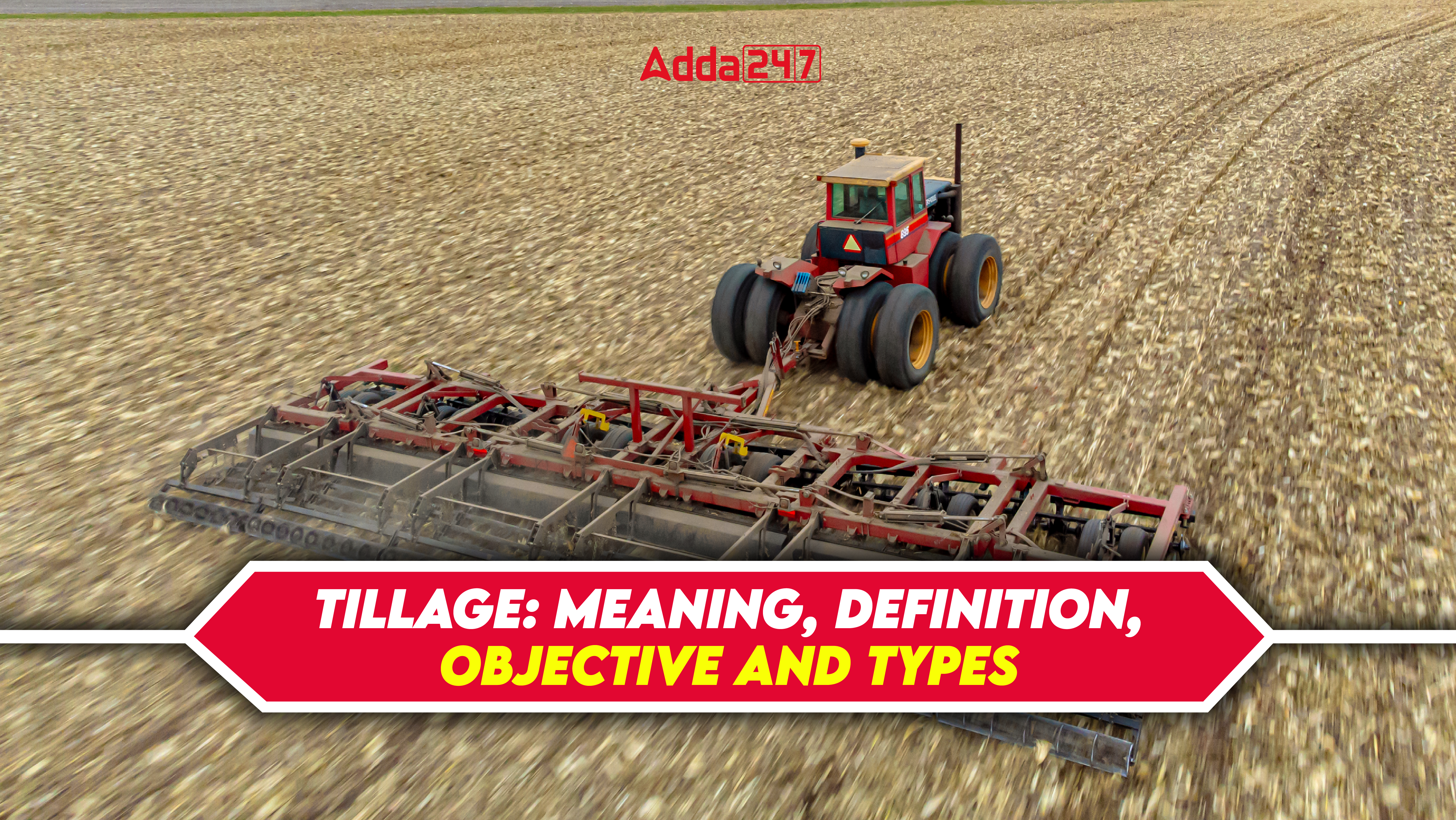Tillage is a fundamental farming practice that prepares the soil for crop cultivation, creating optimal conditions for seed germination and plant growth. Traditionally, tillage involved plowing methods, but it has evolved to incorporate modern techniques that balance productivity with environmental sustainability. This practice is essential for enhancing crop yields and managing soil health. In this article, we will explore the objectives of tillage and the various types employed in agriculture today.
Tillage: What is it?
The term “tillage” originates from two Anglo-Saxon words, Tilian and Teolian, meaning to plough and prepare the soil for planting and crop production. Jethro Tull, often regarded as the Father of Tillage, stressed the importance of thorough ploughing to break the soil into fine particles. Tillage involves using various tools to mechanically alter the soil, creating optimal conditions for crop growth, seedling establishment, and seed germination. This process results in a soil condition known as “tilth,” which can be classified as moderate, fine, or coarse based on the size of the soil particles.
Objectives of Tillage
The major objectives of tillage are:
- Seedbed Preparation: It involves tillage which loosens and makes friable soil bed to encourage root growth and seed germination.
- Weed Control: Tillage reduces competition for sunlight, water, and nutrients by uprooting or burying weeds which inhibits their growth.
- Soil Aeration and Drainage: By releasing compacted layers and enabling oxygen to reach plant roots tillage promotes soil aeration. Additionally, it improves drainage which lowers the chance of waterlogging.
- Incorporation of Organic Matter: Tillage aids in the soil’s nutrient enrichment and fertility enhancement by incorporating organic amendments such as manure or compost.
- Pest Control: By exposing pests to adverse environments or predators tillage can disrupt pest habitats and lower pest populations.
- Soil Reshaping: Tillage may occasionally be utilized to reshape the soil surface to improve erosion prevention, water management, or land leveling.
Types of Tillage
Tillage operations are crucial for effective agricultural management, as they prepare the soil to promote optimal crop growth. These operations are generally classified into two main types:
- On- Season Tillage
- Off- Season Tillage
On-season tillages are conducted during the crop season to prepare fields for planting or to maintain crop health. These practices encompass deep soil loosening, weed control, incorporation of organic matter, soil aeration, and nutrient application. On-season tillage is generally divided into two main categories: preventive tillage and corrective tillage.
| On-season Tillage | ||
| Major On-season Tillage | Sub-division | Description |
| Preparatory Tillage | Primary Tillage |
|
| Secondary Tillage |
|
|
| After-cultivation (Inter-Tillage) | – |
|
Off-season tillages are conducted outside of the crop growing season, typically during dormancy, to prepare the soil for the next planting cycle. These practices emphasize soil conservation, erosion control, and the incorporation of cover crops to improve soil structure and fertility. Types of off-season tillage include post-harvest tillage, performed after crop harvest; summer tillage, which takes place during the summer months; winter tillage, done in winter to prepare the soil for spring planting; and fallow tillage, where the field is left bare for a period to manage soil health and weeds while allowing the land to rest. Together, these practices contribute to sustainable agricultural systems and enhance soil vitality.
Modern Concepts in Tillage
In conventional tillage, the process begins with primary tillage, which turns and breaks up the soil to prepare it for planting, followed by secondary tillage to create a suitable seedbed for sowing. However, the introduction of herbicides in intensive farming systems has shifted the role of tillage. Heavy plowing can lead to the formation of a hard pan in the subsoil, which hinders water infiltration and increases the risk of runoff and erosion. This not only accelerates soil degradation but also requires significant financial investment. To address these challenges and mitigate negative effects, modern farming techniques have emerged.
Key concepts include conservation tillage, which minimizes soil disturbance; no-till farming, which eliminates tillage; cover cropping, to enhance soil fertility; precision agriculture, which leverages technology for targeted management; and integrated weed management, which combines various practices to control weeds while reducing reliance on tillage. These approaches aim to promote sustainable agriculture and improve long-term soil health.
- Minimum Tillage
- Zero Tillage or No Tillage
- Stubble mulch Tillage
- Conservation Tillage
Minimum Tillage:
In this tillage operations are reduced to get a good seed bed. This type of tillage can be done in three different ways:
- Row-zone Tillage: Primary tillage is done with mould board plough in the entire area of the field and secondary tillage is reduced within a row zone.
- Plough plant Tillage: In this technique, after primary tillage one run is done over the field, the row zone is pulverized and seeds are sown by the planter.
- Wheel track tillage: In this technique, after primary tillage tractors are used for sowing and the wheels of the tractor pulverize the row zone in which planting is done.
Zero Tillage or No Tillage
In zero tillage, a new crop is planted directly into the existing soil bed or crop residues from the previous season without disturbing the soil. This method is effective primarily when weeds are controlled using herbicides. Zero tillage works best in soils with a coarse-textured surface, good internal drainage, high biological activity of soil fauna, a favorable initial soil structure, and adequate crop residue to serve as mulch. By minimizing soil disturbance, zero tillage helps preserve soil health and moisture while enhancing sustainability in agricultural practices.
One approach within zero tillage is till planting, which involves using a wide sweep and trash bar to clear a narrow strip over the old crop row. This method creates a small trench into which the planter places the seeds. After planting, the seeds are covered, allowing for minimal soil disturbance while effectively preparing the field for the new crop. This technique helps maintain soil health and moisture retention while facilitating efficient planting.
Stubble mulch Tillage
Soil protection is achieved either by growing a crop or by leaving crop residues on the soil surface. This technique involves using blades to cut into the top layer of soil, typically to a depth of 12 to 15 cm during the initial operation after harvest, with subsequent cuts being shallower. The two main methods used in this technique are:
- A wide sweep and trash bar is used to clear a strip and a narrow planter shoe opens a narrow furrow into which seeds are placed.
- A narrow chisel is used to cut soil at a depth of 15-30 cm leaving all residue on the surface of the soil. It shatters the tillage pans and planting is done with special planters.
Conservation Tillage
In this technique, organic residues are left on the soil surface instead of being mixed into the soil. These residues create a protective layer that helps prevent soil erosion and reduces moisture evaporation. When stubble remains on the surface as this protective cover, the method is referred to as stubble mulch tillage. This approach is utilized almost year-round and involves managing plant residues, controlling soil erosion, and managing weeds. Practices such as undercutting residues and other methods are employed to keep the soil covered and protected, enhancing soil health and sustainability in agricultural systems.
Main Field Preparation
Tillage operations are broadly categorized into preparatory cultivation and post-cultivation. Preparatory cultivation, also known as main field preparation, includes several key steps:
- Primary Tillage: This involves breaking up and loosening the soil to improve its structure and incorporate organic matter. Tools commonly used for this include disc plows, country plows, and mould board plows.
- Secondary Tillage: This follows primary tillage and refines the soil to create a smooth seedbed. Harrows and cultivators are typically used for secondary tillage, although the same tools may sometimes serve both purposes.
- Sowing Layout: After tillage, the field is prepared for planting by creating features such as beds, channels, pits, ridges, and furrows. These modifications help optimize conditions for seed planting and contribute to higher agricultural yields.



 RSMSSB Agriculture Supervisor Recruitmen...
RSMSSB Agriculture Supervisor Recruitmen...
 IBPS AFO Mains Cut Off 2025 Out, Check C...
IBPS AFO Mains Cut Off 2025 Out, Check C...
 IBPS RRB Agriculture Officer Exam Date 2...
IBPS RRB Agriculture Officer Exam Date 2...




 Adda247 Job portal has complete information about all Sarkari Jobs and Naukri Alerts, its latest recruitment notifications, from all state and national level jobs and their updates.
Adda247 Job portal has complete information about all Sarkari Jobs and Naukri Alerts, its latest recruitment notifications, from all state and national level jobs and their updates.



